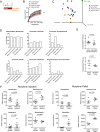The gut microbiota mediates reward and sensory responses associated with regimen-selective morphine dependence
- PMID: 30258112
- PMCID: PMC6224506
- DOI: 10.1038/s41386-018-0211-9
The gut microbiota mediates reward and sensory responses associated with regimen-selective morphine dependence
Abstract
Opioid use for long-term pain management is limited by adverse side effects, such as hyperalgesia and negative affect. Neuroinflammation in the brain and spinal cord is a contributing factor to the development of symptoms associated with chronic opioid use. Recent studies have described a link between neuroinflammation and behavior that is mediated by a gut-brain signaling axis, where alterations in indigenous gut bacteria contribute to several inflammation-related psychopathologies. As opioid receptors are highly expressed within the digestive tract and opioids influence gut motility, we hypothesized that systemic opioid treatment will impact the composition of the gut microbiota. Here, we explored how opioid treatments, and cessation, impacts the mouse gut microbiome and whether opioid-induced changes in the gut microbiota influences inflammation-driven hyperalgesia and impaired reward behavior. Male C57Bl6/J mice were treated with either intermittent or sustained morphine. Using 16S rDNA sequencing, we describe changes in gut microbiota composition following different morphine regimens. Manipulation of the gut microbiome was used to assess the causal relationship between the gut microbiome and opioid-dependent behaviors. Intermittent, but not sustained, morphine treatment was associated with microglial activation, hyperalgesia, and impaired reward response. Depletion of the gut microbiota via antibiotic treatment surprisingly recapitulated neuroinflammation and sequelae, including reduced opioid analgesic potency and impaired cocaine reward following intermittent morphine treatment. Colonization of antibiotic-treated mice with a control microbiota restored microglial activation state and behaviors. Our findings suggest that differing opioid regimens uniquely influence the gut microbiome that is causally related to behaviors associated with opioid dependence.
Conflict of interest statement
The authors declare no competing interests.
Figures




Similar articles
-
Fecal microbiota transplantation and antibiotic treatment attenuate naloxone-precipitated opioid withdrawal in morphine-dependent mice.Exp Neurol. 2021 Sep;343:113787. doi: 10.1016/j.expneurol.2021.113787. Epub 2021 Jun 18. Exp Neurol. 2021. PMID: 34153321 Free PMC article.
-
Neonatal exposure to morphine results in prolonged pain hypersensitivity during adolescence, driven by gut microbial dysbiosis and gut-brain axis-mediated inflammation.Brain Behav Immun. 2025 May;126:3-23. doi: 10.1016/j.bbi.2025.01.021. Epub 2025 Feb 1. Brain Behav Immun. 2025. PMID: 39900146
-
Morphine induces changes in the gut microbiome and metabolome in a morphine dependence model.Sci Rep. 2018 Feb 26;8(1):3596. doi: 10.1038/s41598-018-21915-8. Sci Rep. 2018. PMID: 29483538 Free PMC article.
-
The role of the gut microbiome in opioid use.Behav Pharmacol. 2020 Apr;31(2&3):113-121. doi: 10.1097/FBP.0000000000000538. Behav Pharmacol. 2020. PMID: 31895059 Free PMC article. Review.
-
Opioid system influences gut-brain axis: Dysbiosis and related alterations.Pharmacol Res. 2020 Sep;159:104928. doi: 10.1016/j.phrs.2020.104928. Epub 2020 Jun 3. Pharmacol Res. 2020. PMID: 32504837 Review.
Cited by
-
The Gut-Brain Axis in Opioid Use Disorder: Exploring the Bidirectional Influence of Opioids and the Gut Microbiome-A Comprehensive Review.Life (Basel). 2024 Sep 25;14(10):1227. doi: 10.3390/life14101227. Life (Basel). 2024. PMID: 39459527 Free PMC article. Review.
-
The "Culture" of Pain Control: A Review of Opioid-Induced Dysbiosis (OID) in Antinociceptive Tolerance.J Pain. 2020 Jul-Aug;21(7-8):751-762. doi: 10.1016/j.jpain.2019.11.015. Epub 2019 Dec 11. J Pain. 2020. PMID: 31841668 Free PMC article. Review.
-
Manipulation of Gut Microbiota as a Key Target for Crohn's Disease.Front Med (Lausanne). 2022 Jun 16;9:887044. doi: 10.3389/fmed.2022.887044. eCollection 2022. Front Med (Lausanne). 2022. PMID: 35783604 Free PMC article. Review.
-
The Microbiome and the Gut-Liver-Brain Axis for Central Nervous System Clinical Pharmacology: Challenges in Specifying and Integrating In Vitro and In Silico Models.Clin Pharmacol Ther. 2020 Nov;108(5):929-948. doi: 10.1002/cpt.1870. Epub 2020 May 29. Clin Pharmacol Ther. 2020. PMID: 32347548 Free PMC article. Review.
-
Cancer and the Microbiome-Influence of the Commensal Microbiota on Cancer, Immune Responses, and Immunotherapy.Gastroenterology. 2021 Jan;160(2):600-613. doi: 10.1053/j.gastro.2020.11.041. Epub 2020 Nov 28. Gastroenterology. 2021. PMID: 33253684 Free PMC article. Review.
References
Publication types
MeSH terms
Substances
Grants and funding
LinkOut - more resources
Full Text Sources
Other Literature Sources
Research Materials

